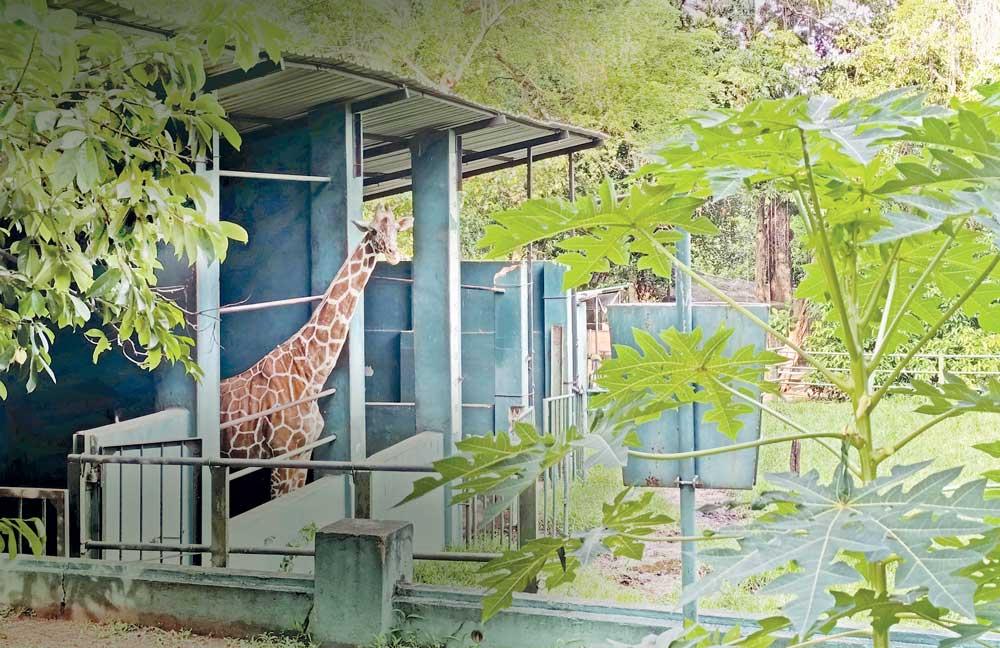Reply To:
Name - Reply Comment

Social media has been abuzz these days with several posts indicating that the Dehiwela Zoological Gardens needs to be shut down.
However, during a recent visit to the zoo premises, the Daily Mirror observed a situation contrary to the claims
All animals are not only being fed well but the team of veterinary doctors go on their daily rounds to check on the health of the animals
Zoological gardens do a great service in terms of wildlife research and education
|
Elephants walking back after their performance
|
Social media has been abuzz these days with several posts indicating that the Dehiwela Zoological Gardens needs to be shut down. Photos of the bear and lion for instance were shared on social media with claims that the animals are in poor health and that the conditions in which they are being kept are appalling. However, during a recent visit to the zoo premises, the Daily Mirror observed a situation contrary to the claims. The animals were in good condition, their cages were cleaned and there was nothing for visitors to complain about.
Living Ex Situ
Animals in an enclosure are maintained outside an ecological niche. Here, they don’t face the same selection pressures as wild populations. The 26-acre expanse of land at the Dehiwela Zoo is home to 4,000 animals belonging to 250 species. The Daily Mirror observed that all animals are not only being fed well but the team of veterinary doctors go on their daily rounds to check on the health of the animals. A visit to the zoo serves as an educational experience for visitors irrespective of their age. Visitors including the young and old are fascinated by the animals, their gestures and even their noises, giving them a chance to rewind and unwind amidst a heavily urbanised city.
|
Chimpanzees |
A gracious Orang Utan |
Pacing through 35 years of existence |
A call to minimize animal cruelty
 But for many years, animal rights advocates have been raising concerns about animals in captivity. They suggest that the Dehiwela Zoological Gardens, the Pinnawala Zoo and the Elephant orphanage should be phased out to display larger mammals such as elephants. “When people say that the zoo has to be closed down they don’t mean that it should be done overnight,” said Panchali Panapitiya, Founder - Rally for Animal Rights and Elephants (RARE), a non-profit organisation that has been vocal about captive animals.
But for many years, animal rights advocates have been raising concerns about animals in captivity. They suggest that the Dehiwela Zoological Gardens, the Pinnawala Zoo and the Elephant orphanage should be phased out to display larger mammals such as elephants. “When people say that the zoo has to be closed down they don’t mean that it should be done overnight,” said Panchali Panapitiya, Founder - Rally for Animal Rights and Elephants (RARE), a non-profit organisation that has been vocal about captive animals.
She further said that there has to be a mechanism to cut down on breeding to avoid overcrowding at the Zoo. “Perhaps the authorities could look at sending some animals to the Ridiyagama Safari Park. There needs to be better approaches in place to handle animals professionally and the staff needs to be trained on positive reinforcement techniques.”
Keeping animals in captivity gives rise to many mental and physical health issues and therefore unlike wild animals, zoo animals don’t lead a normal life. Panapitiya recalled incidents of animals that have died due to negligence and urged authorities to launch inquiries and investigate these matters.
A place of great service
 “When it comes to zoological gardens, many people think that it’s still a place where animals are brought from the natural environment and given a permanent residence which is cruel and unethical,” said Sethil Muhandiram, conservationist and Founder – Leopocon.
“When it comes to zoological gardens, many people think that it’s still a place where animals are brought from the natural environment and given a permanent residence which is cruel and unethical,” said Sethil Muhandiram, conservationist and Founder – Leopocon.
He explained about In-situ and Ex-situ conservation, two wildlife conservation methods that have been practiced for decades. “In in-situ conservation, we conserve wildlife by keeping them within their natural habitat and in ex-situ conservation, species which need special care and attention are taken out of their habitats and preserved outside. This is where zoological gardens come in handy.”
“Zoological gardens do more than what we imagine. When it comes to wildlife conservation, there are species that are about to face extinction or are under threat of becoming extinct from the wild. These species face multiple threats which are man-made and climate-related. Nowadays, you can see species that have only been protected in zoos due to loss of their natural surroundings. In certain cases, when these animals have been disturbed in their natural habitats, zoos have preserved and rebred them into the wild so that they can be returned and to populate in their natural habitats. The California condor and Arabian oryx are classic examples of result-based ex-situ conservation programmes.”
He further said that zoological gardens do a great service in terms of wildlife research and education. “Zoological gardens exhibit species that attract domestic and foreign tourists while carrying out awareness programmes and entertainment.”
Specifications of a zoo
In terms of the definition of a zoo, there is little, non-binding guidance from CITES on what defines a “zoo.” Sethil explained that according to CITES documents, aspects such as physical housing (size and space [adequate space to display normal behavior; to expand as the animal grows; availability of indoor/outdoor housing; and if the animal is on public display, availability of private, off-exhibit area], construction materials, shelter from sun/rain, safety and security measures, appropriate arrangements for quarantine, substrate type], should be recommended under the guidance for evaluation when determining whether the proposed recipient of a living specimen is suitably equipped to house and care for it.”
Criteria also include furnishings for enclosures that are species-specific (e.g., pools, climbing frames, hides, nest boxes, plants, and hiding spots), animal husbandry and care (environment, including ideal temperatures and lighting; aquatic species’ water quality standards), dietary demands (food and nutritional requirements particular to a species, availability of drinkable water).
He said that sufficient resources for appropriate veterinarian and animal care, including enough personnel and knowledge to handle animals, awareness of illnesses, and preventative medicine, wildlife laws (acquire and maintain the necessary permits and licenses for the species in question, as well as abide by all applicable wildlife laws and/or regulations), Animal behavior and social well-being (suitable social groups for the species, integration strategies, suitable behavioral and social enrichment, and the capacity to split the group when necessary), Management (keeping proper records at the site); Any additional taxon-specific issues are required.
He further said that the Dehiwala Zoological Garden also preserves a large number of endangered species in Sri Lanka. He commended the efforts made by the zoological gardens to breed a large number of wildlife species and to introduce them back into their natural environments, a process known as re-wilding. “Under such re-wildling initiatives, species such as Reptiles, Snakes, Fish and Wild Cats were reintroduced to their natural habitats under extended and scientific conservation plans. It’s easy to close down a zoo based on sensitivity, yet we should think twice and reevaluate such actions before doing or even speaking about them.”
Speaking about several aspects that need to be addressed, Muhandiram said that the Dehiwela Zoo should look at introducing modern-day zoological garden practices, improving Quality of Life (QoL) on species under benchmarking and carrying out assessments. “These methods depend on species, their behaviours and their natural habitat requirements. We should look into cages and enclosures while making them habitable and improve their QoL standards. As mentioned under CITES non-binding guidance we can re-create and convert our current zoos into safe and long- lasting ex-situ conservation centers that will benefit both wildlife and society,” he underscored.
Attempts by parties with vested interests to close down the zoo : Zoo Director
 The Dehiwela Zoo is one of the main attractions in Colombo. However, according to sources, parties with vested interests have allegedly been leading campaigns to close down the premises.
The Dehiwela Zoo is one of the main attractions in Colombo. However, according to sources, parties with vested interests have allegedly been leading campaigns to close down the premises.
“All ex-situ conservation activities happen here,” said Ranjan Marasinghe, Director- Department of National Zoological Gardens. “We talk about climate change. Animal lovers are against climate change and they want to manage it. In climate change subject matter we talk about climate change adaptation. There are endemic and vulnerable species as a result of climate change. As such the zoological garden has a bigger role to play in this aspect.”
Ex-situ conservation takes place in collaboration with the Department of Wildlife. He further said that the zoological garden along with several wildlife organisations is in the process of breeding and re-wilding several species that are on the brink of extinction. “The Asoka Barb is one of them. We are now going to the field and working with communities for conservation. But there’s another fragment of the community that doesn’t like to see such activities taking place.”
Even though many efforts are being made to improve research and education facilities, Marasinghe admits that everything is not as perfect as it seems to be. In response to a query on the bear, Marasinghe said that the bear is 36 years old. “It is said that 37 years is the maximum lifespan for a bear. If this bear lives for the next two years then we are going to break a record! Are we not supposed to have any due credit for looking after the animals this way? If we match that with human age the bear is equivalent to a 110-year-old man. Most animals are old and they are living because we don’t euthanise them and they live until they die naturally. That is how we love these animals. The giraffes are of record-breaking ages. There was one giraffe that was 45 years old. He was the oldest giraffe in the world. Most of them are nearing their maximum lifespan. From wild horses to one of the lions that were photographed and shared on social media. The maximum lifespan for a lion is 12 years but this lion is 14 years. He survived COVID-19 as well.”
The Daily Mirror learned that the lions are breeding due to better environmental conditions they are living in.
“The pygmy hippos that are being bred for instance are in very good condition because Sri Lanka is the best place for them to breed,” he continued. “This is a very rare sight. If we maintain an insurance stock population in certain countries then we could play a role in re-wilding an animal that has become extinct.”
As such, the animals at the zoo are very old. However, the animal exchange programmes have been revived recently and Marasinghe feels that visitors will have a chance to see healthier animals in the future.
According to Marasinghe the annual expenditure of the zoo sums up to around Rs. 1.7 billion. But their predictions indicate that they could earn a surplus of Rs. 3 billion this year. “I want to put it back for development but the biggest challenge at present is the lack of human resources. There are many vacancies at the moment since the government decided to hold recruitments. As a result our engineering and technical capabilities are poor. So far there are only five staff members working at the head office while we actually need a cadre of around 50 staff members.”
|
A fully grown black leopard |
“Some have questioned me on why the number of animals is less,” Marasinghe continued. “This is because if we want to reduce the density and keep a bigger space for individual animals then we have to cut down the numbers. We want to maintain Dehiwela as a city zoo and keep an optimum number of iconic animals for the public to come and see and learn.”
He also commended the efforts made by the Young Zoologists Association to encourage the next generation of wildlife and nature lovers to take the mantle of wildlife conservation forward. “Many conservationists in Sri Lanka began their journey in conservation at YZA. This argument itself is enough to sustain the zoo,” he added.
Marasinghe also spoke about his plans to revive the Ridiyagama Safari Park into a major tourist attraction in the South. Marasinghe blamed people’s ignorance for their attempts to close down the zoo. “We never publicize our work. We have introduced many e-governance initiatives to facilitate a better experience for visitors. The public has a great deal to benefit from a new range of courses that we have introduced. The zoo is like a university and you should never close down a university,” he said in conclusion.